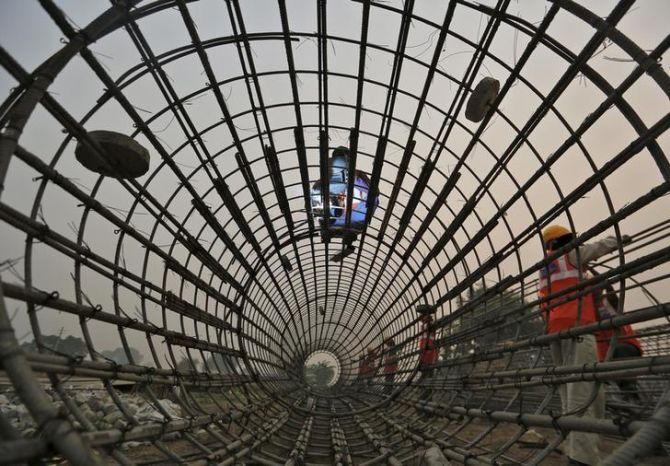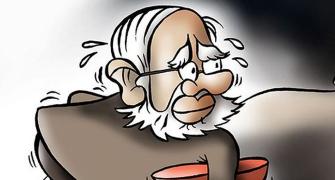The previous high GDP growth of 8.1 per cent was recorded in April-June quarter of 2016-17.

India's GDP grew at the fastest pace in seven quarters at 7.7 per cent in January-March, retaining the fastest growing major economy tag on robust performance by manufacturing and service sectors as well as good farm output.
India's economic expansion at 7.7 per cent was significantly higher than China's 6.8 per cent in the January-March period.
However, the Indian economy on yearly basis grew at a four-year low of 6.7 per cent in 2017-18, down from 7.1 per cent in the previous fiscal.
The previous low was recorded in 2013-14 at 6.4 per cent.
"GDP at 2011-12 prices in the fourth quarter of 2017-18 registered growth rate of 7.7 per cent as against 5.6 per cent , 6.3 per cent and 7 per cent, respectively, in the first three quarters, Q1, Q2 and Q3 of 2017-18.
 “Rapid growth in agriculture (4.5 per cent), manufacturing (9.1 per cent) and construction (11.5 per cent) contributed to the overall growth," the Central Statistics Office (CSO) said in its national accounts data released on Thursday.
“Rapid growth in agriculture (4.5 per cent), manufacturing (9.1 per cent) and construction (11.5 per cent) contributed to the overall growth," the Central Statistics Office (CSO) said in its national accounts data released on Thursday.
The previous high GDP growth of 8.1 per cent was recorded in April-June quarter of 2016-17. The GDP growth was 6.1 per cent in January-March in 2016-17.
"GDP growth has been increasing continuously every quarter with growth of 7.7 per cent in Q4 of 2017-18. Shows that the economy is on the right track and set for even higher growth in the future," tweeted Finance Minister Piyush Goyal.
Finance secretary Hasmukh Adhia said that the constant increasing trend of quarterly GDP numbers in "the four-quarters of 2017-18 at 5.6 per cent, 6.3 per cent, 7 per cent and 7.7 per cent indicates that the structural measures of reforms undertaken by government is now bringing rich dividends in the form of higher GDP Growth Rate".
Meanwhile, the government managed to restrict the fiscal deficit for 2017-18 at 3.53 per cent of the GDP, broadly in line with the revised target.
Meanwhile, eight infrastructure industries recorded 4.7 per cent growth in April helped by healthy performance in segments like coal, natural gas and cement.
The decline in the annual GDP growth has been mainly on account of manufacturing, agriculture, mining and some services. However, construction and financial service had shown some improvements.
The government has kept its economic growth forecast for current fiscal unchanged at 7.5 per cent buoyed by turnaround in manufacturing and pick up in investment.
"I don't think we are revising our forecast for the current year 2018-19 which was indicated at 7.5 per cent. We retain it at this moment at this level.
“There has been some downward revision by Moody's and others taking oil prices into consideration, but there is no one to one relation between oil price and GDP growth," Economic Affairs Secretary Subhash Chandra Garg told reporters.
Chairman of the Economic Advisory Council to the Prime Minister Bibek Debroi said the GDP numbers are a reflection of the fact that the momentum in growth trajectory continues.
On the quarterly basis the Gross Value Addition (GVA) for January-March quarter has been pegged at 7.6 per cent up from 6 per cent a year ago.
Manufacturing sector GVA grew at 9.1 per cent in fourth quarter up from 6.1 per cent year ago.
Similarly Construction sector grew at 11.5 per cent in fourth quarter compared to a contraction of 3.9 per cent year ago.
Mining and quarrying did not perform well in January-March quarter as GVA of the segment grew at 2.7 per cent in fourth quarter down from 18.8 per cent in the year ago period.
Though the farm GVA output growth was well above satisfactory mark of 4 per cent at 4.5 per cent in fourth quarter, it was lower than 7.1 per cent year ago.
Real GVA, (at basic constant (2011-12) prices for 2017-18 is now estimated at Rs 119.76 lakh crore showing a growth rate of 6.5 per cent over First Revised Estimates of GVA for 2016-17 of Rs 112.48 lakh crore. The GVA growth was 7.1 per cent in 2016-17.
A barometer of investment, the Gross Fixed Capital Formation (GFCF) at current prices is estimated at Rs 47.79 lakh crore in 2017-18 as against Rs 43.52 lakh crore in 2016-17.
At constant (2011-12) prices, the GFCF is estimated at Rs 40.88 lakh crore in 2017-18 as against Rs 37.98 lakh crore in 2016-17.
In terms of GDP, the rates of GFCF at current and constant (2011-12) prices during 2017-18 are estimated at 28.5 per cent and 31.4 per cent, respectively, as against the corresponding rates of 28.5 per cent and 31.1 per cent, respectively, in 2016-17.
GDP numbers and fiscal deficit figures are the last set of macro-economic data that have been released before the 2018-19 fiscal's second bi-monthly monetary policy review.
The healthy growth numbers and rising crude oil prices will weigh on the six members of the Monetary Policy Committee (MPC).
The panel is scheduled to meet for three days beginning June 4.
On CSO data, CII director general Chandrajit Banerjee said the rebound in growth reinforces the chamber's assessment that the economy is back on track and set for a strong recovery after the period of disruptions sparked by demonetization and GST implementation.
Photograph: Anindito Mukherjee/Reuters









